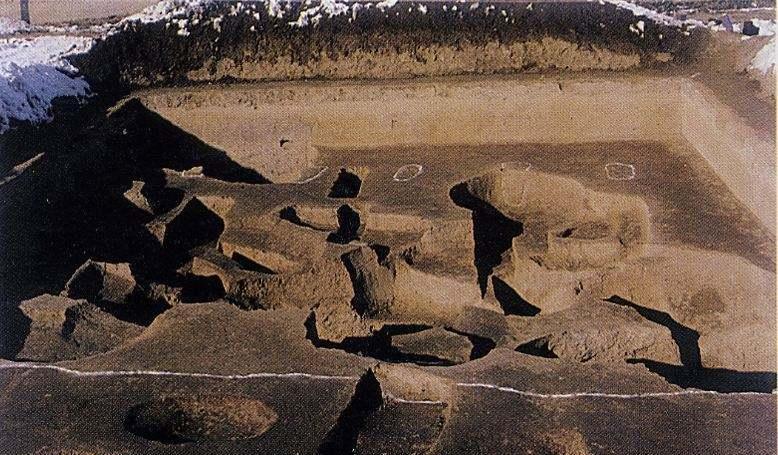In the collection circle, ancient coins have always been highly sought after, and there are some very special coins, such as the thorn coin is one of them. In the ruins of Henan Master Gu, experts also found some thorn coins, but after in-depth research, it was found that it was not an ancient coin, but a daily necessity that is now common in rural areas... What's going on here? What is a thorn coin? Let's let the editor reveal it.

(All pictures in this article, all from the network, thanks to the original author, if you infringe your rights, please contact the author of this number to delete.) The picture has nothing to do with the content, please do not enter the seat)
In September 2002, in Guangwu Town, Xingyang, Henan Province, the local villagers stumbled upon a lot of rammed foundations while cultivating the land, and also dug out some pottery. Prior to this, archaeologists had gone to Guangwu Town to investigate and look for ancient sites, but unfortunately they never found it, so when the villagers found rammed earth, they suspected that it was the site that experts were looking for, so they contacted the experts of the local museum for the first time. In the afternoon, a team of archaeologists drove to the town of Guangwu, where they were led by villagers to the place where rammed earth and pottery were found.
After investigation, the experts found that it was located on a riverside plain in the village of Master Gu, which was very geographically advantageous, and in the process of in-depth excavation, a large area of rammed earth walls was also found. From this, experts determined that this was an ancient city site, and according to the characteristics of the site, they determined that it belonged to the Erlitou cultural site, that is, the site of the city during the Xia Dynasty, and named it "Master Gucheng Ruins" according to the custom. In the months that followed, experts also determined the specific structure of the city site, with a total area of about 510,000 square meters.
In the process of excavation of the ruins of Master Gucheng, experts also found a large number of house ruins, tomb pits and ash pits, etc., which are of great value for studying the characteristics of life in the Xia Dynasty, in addition to a large number of cultural relics, the richest and most exquisite of which are various types of jade, such as Yuzhang, Yubi and Yuhuan. However, experts have also found a small number of bronzes, the most special bronze double "stick" bronze.
The double "stick" bronze is about 14.5 cm long, and later experts have studied it as a spiny coin. The so-called "thorn coin", whose name comes from the appearance characteristics, is recorded in the "Continuation of the Spring Hui" compiled by the Qing Dynasty, "This product may not be a spring coin... Stored for a different purpose", indicating that the thorn coin is an ancient coin. Therefore, archaeologists believe that the spiny coin is a metal currency of the Xia Dynasty, and there are many spiny coins circulating in the folk collection circle. For example, at auction, a small Spring and Autumn Thorn Coin can be worth tens of thousands of yuan, and if it is old, the estimated value can be millions.
In this way, the spiny coin has always been taken for granted as an ancient coin, but experts have found that this is not the case in later studies. First, archaeologists found some green matter in the place where the thorn coins were unearthed, and later scientific tests determined that it was originally a crystallization of silk rot. Then, experts also found a distinct filamentous substance on some spiny coins. Therefore, the question arises, how can there be silk and silk thread on ancient coins?
For a while, experts are also difficult to give a definitive answer, but it can be determined that the spiny coin may not be an ancient coin. Since then, archaeologists have also found textile tools, such as pottery spinning wheels, in the ruins of Master Gucheng, which also indicates that the ancestors of the Xia Dynasty at that time had mastered textiles. Experts say that since the ancients could weave silk threads, where would they put them? Suddenly, all the problems seem to be solved, since there is silk thread on the spiny coin, it means that the ancients wrapped the silk thread on the spiny coin for preservation, so the role of the spiny coin is to wind the wire, not the ancient coin that people previously thought it was. According to this, experts also gave the spiny coin a new name for grounding - the wire plate.
In addition to the ruins of Master Gucheng, in the Qingbaijiang Han Dynasty ruins in Sichuan and the Qiantang River Spring and Autumn Ruins in Hangzhou, experts have also found some so-called thorn coins, and textile utensils have also been found near the thorn coins excavated from the Qingbaijiang Han Dynasty sites, which also indicates that their supporting tools, that is, the silk threads are wrapped around the thorn coins after the completion of the weaving. Later, people's misunderstanding of the thorn coin has also been corrected, which shows that the role of archaeology is still quite large, not only can find the ancient social landscape, but also correct some errors in understanding.
Nowadays, the excavation of the ruins of The Master Gucheng is still continuing, in addition to the thorn coins, there are also many special cultural relics, showing us the social style of more than 4,000 years ago, so that we can have a lot of understanding of the mysterious Xia Dynasty, and this is the charm of archaeology.
Resources:
The Complete Book of Numismatic Appreciation by Zhang Bingjian, Publisher: Central Compilation Publishing House
Wenlan Hairun Studio Editor-in-Chief Wen Xiucai, this article is written by: Special History Writer: Liu Lijiang's